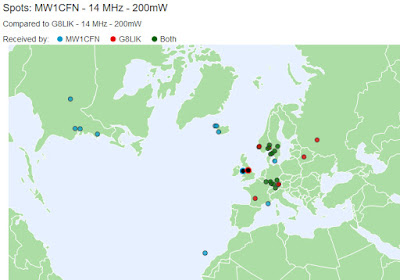This week, I have some spare time. The weather is at the stage where it's still very warm, but the spirit of autumn is there, in the wind and the sky.
Yesterday afternoon was perfect for a fairly brief test down at the coast of my magnetic loop using WSPR. Not only did I get to obtain some valuable results, but also a nice conversation with a tourist and some geography students from Durham University. Very pleasingly, the visitors were willing to ask what I was doing with my strange copper tube,
and take a genuine interest in how WSPR worked in tandem with the internet, and how they could see the results on my mobile phone. There is something to be learned, there, about how to improve our relations with the general public...
 |
| My homebrew magloop and stand all fits neatly on the back seat. |
Rather than simply place the loop somewhere and look at the global results, I had a very specific aim in mind.
This aim arose because of the following:
(1) The best one can generally hope for when operating down at the seaside is about 180 degrees of water in front of you. A lot of good locations are not readily accessible, and one has to settle for the few places with reasonably easy car access.
(2) The north coast of Anglesey is ideal for transmitting to and receiving from stations located in Iceland.
(3) The Icelandic stations have recently been reliably available at all times. The availability of WSPR stations for anything more than about a day is a big problem. Very few stations are listening and/or transmitting over long timescales, which makes identifying patterns hard.
(4) A vertical magnetic loop works best with its two vertical sides aimed at the location of interest, because this is the plane where a strong, dipole-like, vertically polarised figure-of-eight pattern is produced.
As it turned out, the tide was just past its lowest state on a spring tide, which wasn't ideal. Even so, I had a good 45-degree swathe of open water centred on Iceland in front of me, so I set up the WSPRlite, to see how far 200mW would go through what many people still call a 'dummy load'.
The stand I built, which includes levelling feet, proved to be adequate if large stones were placed to stabilise it, and a single kite string used to stop swaying. In general, the stand needs to change to a large tripod, with its apex at the top of the magloop so that it will be much more easily deployed on uneven ground and have more resistance to wind, without stones and string!
 |
| Not the best tidal state, but it was clear to Iceland! |
To ensure some kind of context, I also set up my rig back home to send an oscilloscope-calibrated 200mW at 14MHz from my vertical delta loop at the same time. Remember that this is situated over extremely mineralised ground overlooking the Irish Sea from a 100m ridge. On listening tests, this antenna typically gets to anything between number 8 and number 4 in the top WSPR stations across the world.
 |
| Stable in a 22mph wind - with help from rocks and kite string! |
The results? Well, let's just remember this was a 1m-per-side, 15mm outside diameter copper tube loop at the seaside, running against an 8m-tall, full wavelength wire delta loop on top of an old copper mine.
Test period = 13:18 to 15:40UT, 22/08/2018.
Magnetic loop distance from water's edge: maximum 3m, minimum 1m (0.14 to 0.04 wavelength), incoming tide.
Matching of SARK-110 analyser, air-spaced capacitor with 6:1 reduction drive: 1.15:1 SWR.
Magloop, 200mW (operating as MW1CFN):
Median SNR of 26 spots at TF1A =
-4.5dB, standard deviation: 2.0dB
Delta loop, 200mW (operating as GB8WOW):
Median SNR 26 spots at TF1A =
-4.5dB, standard deviation: 2.3dB
A
zero difference!
For 'external' comparison, I looked also at G0CCL, which is a centre-loaded vertical monopole mounted on lots of industrial metal pipework, and has a very good performance over a long timescale.
G0CCL, 200mW:
Median SNR of 37 spots at TF1A =
-5.0dB, Standard deviation of 7.5dB
As I have found before, a magnetic loop is once again definitively shown not to be a 'dummy load'. Down at the seaside, the magnetic loop is able to match the performance of a full wave wire loop, which itself is in an extremely good location.
We have to remember - and the articles in magazines almost never mention this - that
the antenna environment is absolutely crucial to how well(or not) any particular design works. Sticking a magloop in a garden among a dense housing estate and expecting good results is a bit like trying to look through binoculars with the dust caps on the lenses!
Certainly, as soon as I re-engineer the stand to a tripod type, I will be returning to this and other parts of our coast, to see how long path compares in the autumn. By then, it will be colder - and
much windier!
 |
| What a treat! Image:Wikimedia Commons/Arpingstone. |
To put the perfect topping on a great day, an E3 Sentry AWACS aircraft flew low over me, heading out to the Irish Sea. It's the first time I've ever seen such an aircraft, even living very close to RAF Valley. I suspect there is enhanced interest in
claimed Russian activity in this area at the moment...























